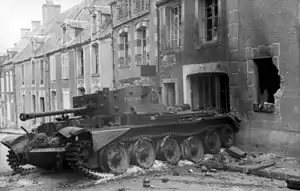
The Battle of Villers-Bocage took place during the Second World War on 13 June 1944, one week after the Allies landed in Normandy to begin the liberation of German-occupied France. The battle was the result of a British attempt to improve their position by exploiting a temporary vulnerability in the German defences to the west of the city of Caen. After one day of fighting in and around the small town of Villers-Bocage and a second day defending a position outside the town, the British force retired. Under the command of Brigadier William "Loony" Hinde, the 22nd Armoured Brigade group reached Villers-Bocage without serious incident, but as its lead elements moved beyond the town on the morning of 13 June they were ambushed by Tiger I tanks of the 101st SS Heavy Panzer Battalion. In fewer than 15 minutes numerous tanks, anti-tank guns and transport vehicles fell victim to the German force, the vast majority being destroyed by SS-Obersturmführer Michael Wittmann's tank. With reinforcements arriving the Germans then launched an assault on the town. Although this was repelled, after six hours Hinde decided to withdraw his force to a more defensible position outside Villers-Bocage. The following day fighting resumed. The British defended their position until a controversial decision was taken to pull the Brigade group back from its salient. Villers-Bocage played no further role in the Second Army's Battle for Caen. (Full article...)